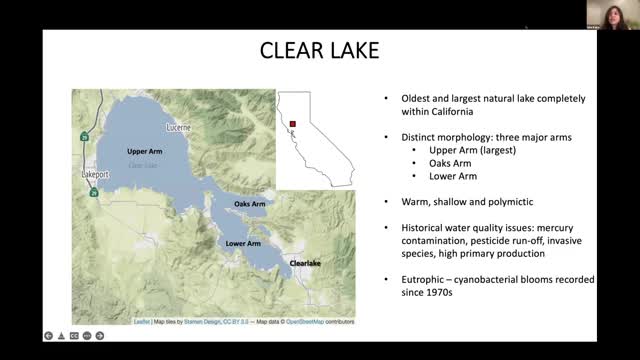Clear Lake study reveals alarming rise in toxic cyanobacterial blooms and environmental impacts
January 24, 2025 | California Water Quality Monitoring Council, Boards and Commissions, Executive, California
This article was created by AI summarizing key points discussed. AI makes mistakes, so for full details and context, please refer to the video of the full meeting. Please report any errors so we can fix them. Report an error »

On January 24, 2025, the California Water Quality Monitoring Council convened a significant meeting focused on the ongoing water quality issues at Clear Lake. The discussions highlighted the lake's historical challenges, including mercury contamination, pesticide runoff, and the proliferation of harmful algal blooms (HABs), particularly cyanobacterial blooms that have increased in frequency and toxicity over recent years.
A key presentation during the meeting detailed the findings from a comprehensive study conducted over three years, from 2019 to 2021. Researchers monitored microcystin concentrations, a toxin produced by certain cyanobacteria, which have been recorded at alarming levels. The study revealed that microcystin levels often exceeded safety thresholds, with the highest concentration reaching approximately 16,000 micrograms per liter in 2016. Seasonal patterns indicated that toxin levels peaked during the summer and fall months, particularly in August and September.
The research aimed to identify the specific taxa responsible for toxin production and to understand the ecological dynamics within the lake's microbial community. It was noted that cyanobacteria constituted a significant portion of the bacterial community, with variations observed year-to-year and month-to-month. The study also emphasized the importance of environmental factors, such as phosphorus and nitrogen levels, in influencing the occurrence of harmful algal blooms.
In addition to the focus on cyanobacteria, the meeting included discussions on the broader microbial community, including eukaryotic organisms. The findings suggested that certain eukaryotic species, like Chlamydomonas, were negatively correlated with microcystin levels, indicating potential competition with toxin-producing cyanobacteria.
The implications of these findings are critical for local ecosystems and public health, as the presence of harmful algal blooms can affect water quality and safety for recreational use and drinking water supplies. The meeting underscored the need for ongoing monitoring and research to develop effective management strategies for Clear Lake.
As the meeting concluded, participants were encouraged to continue discussions and share insights on addressing the challenges posed by water quality issues in Clear Lake, with a focus on collaborative efforts among local stakeholders, including indigenous communities and environmental organizations. The next steps will likely involve further research and the implementation of strategies to mitigate the impacts of harmful algal blooms on the lake's ecosystem and surrounding communities.
A key presentation during the meeting detailed the findings from a comprehensive study conducted over three years, from 2019 to 2021. Researchers monitored microcystin concentrations, a toxin produced by certain cyanobacteria, which have been recorded at alarming levels. The study revealed that microcystin levels often exceeded safety thresholds, with the highest concentration reaching approximately 16,000 micrograms per liter in 2016. Seasonal patterns indicated that toxin levels peaked during the summer and fall months, particularly in August and September.
The research aimed to identify the specific taxa responsible for toxin production and to understand the ecological dynamics within the lake's microbial community. It was noted that cyanobacteria constituted a significant portion of the bacterial community, with variations observed year-to-year and month-to-month. The study also emphasized the importance of environmental factors, such as phosphorus and nitrogen levels, in influencing the occurrence of harmful algal blooms.
In addition to the focus on cyanobacteria, the meeting included discussions on the broader microbial community, including eukaryotic organisms. The findings suggested that certain eukaryotic species, like Chlamydomonas, were negatively correlated with microcystin levels, indicating potential competition with toxin-producing cyanobacteria.
The implications of these findings are critical for local ecosystems and public health, as the presence of harmful algal blooms can affect water quality and safety for recreational use and drinking water supplies. The meeting underscored the need for ongoing monitoring and research to develop effective management strategies for Clear Lake.
As the meeting concluded, participants were encouraged to continue discussions and share insights on addressing the challenges posed by water quality issues in Clear Lake, with a focus on collaborative efforts among local stakeholders, including indigenous communities and environmental organizations. The next steps will likely involve further research and the implementation of strategies to mitigate the impacts of harmful algal blooms on the lake's ecosystem and surrounding communities.
View full meeting
This article is based on a recent meeting—watch the full video and explore the complete transcript for deeper insights into the discussion.
View full meeting
